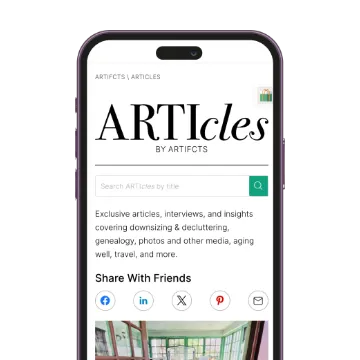Two weeks ago, we kicked off a series of ARTIcles to challenge us all to consider why we have the items we do, what they mean to us, why we keep them, and ultimately for some things, what we want others to know about them as well. We started with one of the most-used rooms in a house, the living room!
This week we’re taking a trip down the hall to tackle all things kids and babies in our kid’s room edition of our “Every Room Has a Story” series. No matter how young or old your child may be, chances are there are memories, treasures, and other, “We still have this?” finds lurking within the walls and corners of our young (or young at heart) one's spaces.
Remember When?
Kids rooms are often filled with mementos (or piles!) big and small that invoke a “remember when” sentiment. It could be any combination of well-loved but out-grown toys, clothing, art supplies, and the like. You can surely relate. Picture this: Dear Child is late for school and needs THAT t-shirt for school today. You run into your kid’s room to help look, searching first under the bed. What do you find instead? A painted skateboard that had been a sixth-grade art project. And you wonder: We still have this because...?
Time is tricky, and what seems like yesterday, may in fact be years ago. And those memories? We think we are going to remember them always, but all too often the small but oh-so-significant details start to slip away. We keep those childhood mementos in hopes of triggering or recalling those memories, but let’s face it, our memories aren’t perfect, and the details get a little fuzzy along with the dust bunnies under the beds.
Our co-founder Heather lives in the city, and since space is at a premium, she and her daughter take time each June to Artifct the art projects, photos, cards, and travel souvenirs they want to keep and display. They also spend time Artifcting the items that may not make the cut (and then recycle them). Being a newly minted teen, this is the first year Heather’s daughter is self-directing this Artifcting project. We'll let you know how it goes!
Books, Books, and More Books
Books may be one of the bulkier clutter culprits in any kid's room. The bookcases are always overflowing, and you find yourself tripping over piles of books when trying to vacuum. “How did we get so many books?” you wonder. Notice the word “get,” not “buy.” Library books count too, and easily add to the piles.
Like adults, kids sometimes enjoy keeping books because they enjoy seeing what they have read. The books make up a visual checklist of how they’ve spent school vacations and rainy-day weekends. For parents, we love to think of books as inherently good and yet they can swiftly become a logistical nightmare meets Tetris challenge of epic proportions.
This year, try a new approach. Does your kid have a dramatic side? Ask for a book review of all the books they no longer plan to read. Artifct those books and their own laugh-out-loud silly reviews. Pair this, as you should with any decluttering effort, with a clear goal. For example, our co-founder Heather plans to nudge her daughter to whittle down her collection to key favorites and the books she will read or re-read. That's it. Our other co-founder, Ellen, uses a different approach with her daughter as they declutter books and reads key passages of some of her daughter’s favorite books, creating one-of-a-kind Artifcts and lasting memories (while also gaining back a bit of space on the family bookshelf).
Stuffed Animals, Lovies, and the Like
What to do with stuffed animals is a favorite topic at Artifcts, so much so that we’ve even written a standalone piece on just that! I won’t rehash the entire ARTIcle here, but the bottom-line up front is the importance of capturing and preserving the memories before letting go. Stuffies have a place in our hearts for good reason, and sometimes it’s the memory that matters more than the battered, tattered, well-loved bunny collection.
One More Thing...
...This is age agonistic advice: No matter how you declutter and organize those kids' rooms, set aside time to have fun, be a little goofy, and lean into the stories and memories of the space.
Take a moment to ask your child(ren) about what those items mean to them, what memories they have for each item. Chances are their memories and their attachment to those items will be very different than our own.
Remember too that decision fatigue is a real thing. Small doses work best no matter your age.
And consider displaying—or what we’ve taken to calling “re-cluttering”—the items that bring them joy and/or create the most functional space. Find fun and age-appropriate storage solutions for the items that need to be put away, and for the items that may not be kept? Artifct that (or them!) and keep the memories while you make room for more age-appropriate ‘stuff.’
_________________
What stories and moments make up your kid's room? Send them in to us at Editor@Artifcts.com or join the conversation on Instagram (@TheArtiLife) or Facebook (@Artifcts). We'd be delighted to hear from you!
###
© 2024 Artifcts, Inc. All Rights Reserved.










 Click the icon to listen to Heather's daughter describe her Artifcting experience.
Click the icon to listen to Heather's daughter describe her Artifcting experience. 



















